ICY DOCK MB559US-1SMB: eSATA Enclosure with Pizzazz
by Gary Key and Dave Robinet on July 11, 2007 12:00 AM EST- Posted in
- Storage
ICY DOCK Specifications
The ICY DOCK MB559US-1SMB provides full support for current eSATA and USB 2.0 specifications along with a case design that features horizontal or vertical positioning. If your system does not natively provide eSATA connections, no worry as ICY DOCK provides an adapter bracket that converts an internal SATA header into an eSATA header that is mounted in an open slot. A USB 2.0 connection is also included for those systems that do not support eSATA or for people on the go who can use this almost universal interface.
ICY DOCK Feature Set
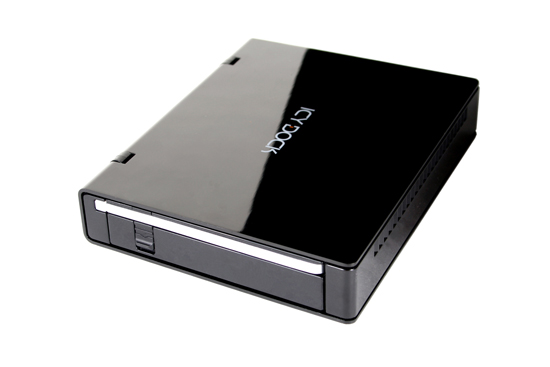
The MB559US features two different color schemes at this time. Not pictured is a brushed silver design with off-white plastic trim that would remind one of the latest Apple designs. Our review sample is the recently released glossy piano black design that looks stunning. Well, at least until it spent a few days in the lab being handled several dozen times and ended up looking like a finger print collection unit. A buffing cloth and a small dab of auto polish brought the unit's glossy black shine back in no time.
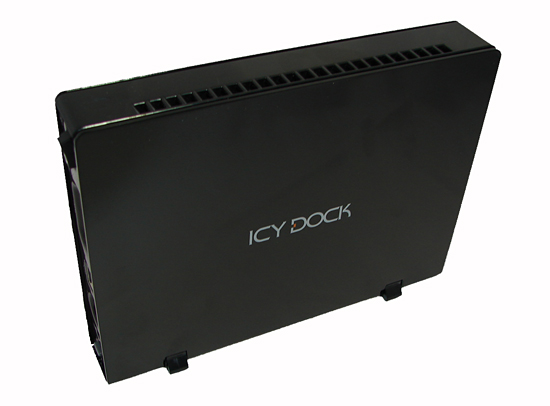
The MB559US enclosure does not include a cooling fan and instead relies on a combination of convection cooling and chassis conduction to cool the enclosed hard drive. It can be positioned either horizontally or vertically, but we found the vertical position to offer less noise, vibration, and heat.
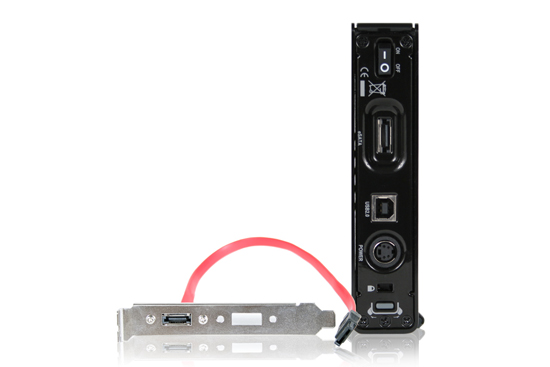
The connections on the back panel are common for this type of enclosure: a power plug that attaches to the external power brick, USB 2.0 and eSATA connections, a button to release the four plastic feet for vertical operation, and a power switch. Interestingly enough, the power switch refused to operate when both of the USB and eSATA connections were filled.
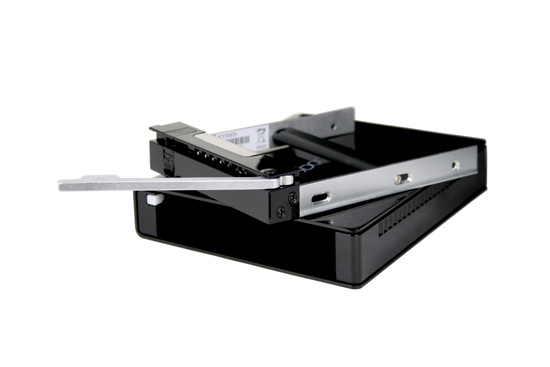
The process of removing the drive the caddy is straightforward. One press of the front button is all that is needed to release the drive, which then slides out easily. Reinserting the drive is just as simple with the only caveat being the lever should be fully extended before pushing the caddy back into place. Once this is done then you close and lock the lever arm.
ICY DOCK has made it easy to swap drives as the caddy utilized is compatible with other enclosures manufactured by them. Besides making the swappable drive process very easy, it also simplifies drive installation since it can be installed in a caddy ahead of time before going in the enclosure. Additional caddy units are available for sale and range in price from around $16 for the silver/white unit to $19 for the black unit.

A quick look at the inside of the unit reveals a spartan PCB layout containing the controller chipset along with the standard SATA data and power connectors.
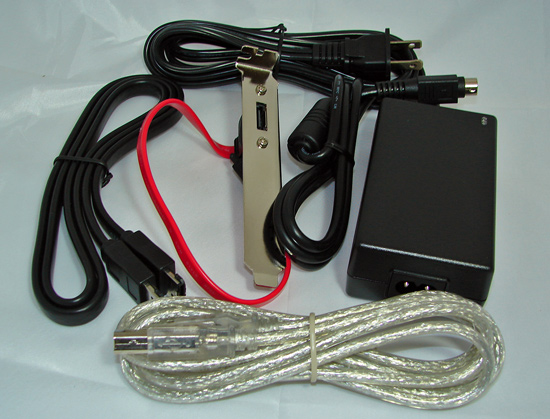
The accessory kit has everything you need to attach the unit to a system with an eSATA or high-speed USB 2.0 port. If your motherboard does not have an eSATA port, you can use the included bracket for attachment to the motherboard's SATA connector. We did not notice any performance or compatibility issues utilizing this method with our test system.
However, if your motherboard's controller chipset does not fully support the eSATA protocol there might be issues using the SATA to eSATA bracket. If this is the case, there might be data corruption if the error correction algorithms do not properly address the communication signal synchronization between the two standards. We have also seen on older controllers like the Intel ICH6 or early VIA chipsets without eSATA support that enabling write-back caching for the drive within Windows will cause data corruption or a locked drive.
| ICY DOCK MB559US-1SMB Specifications | |
| Host Interface | eSATA + USB 2.0 Combination |
| Drive Type | 3.5" SATA 1.5Gb/s or 3Gb/s Interface |
| Drive Position | Vertical or Horizontal |
| Transfer Rates | Up to 3Gb/s per eSATA specs Up to 480Mb/s per USB 2.0 specs |
| Connection Type | SATA |
| Structure Type | Aluminum Body with Plastic Trim |
| Drive Cooling | Passive via Aluminum frame heat dispersion with ventilation ports |
| Activity Indicators | Device Power and Drive Activity via LED |
| OS Support | Windows 98/SE/ME/2000/XP/Vista, Mac OS 9.0 or higher |
| Power Draw | 2W |
| Dimensions (LxWxH) | 194 x 142.6 x 42.6 mm |
| Weight | 1.10 lbs. |
The ICY DOCK MB559US-1SMB provides full support for current eSATA and USB 2.0 specifications along with a case design that features horizontal or vertical positioning. If your system does not natively provide eSATA connections, no worry as ICY DOCK provides an adapter bracket that converts an internal SATA header into an eSATA header that is mounted in an open slot. A USB 2.0 connection is also included for those systems that do not support eSATA or for people on the go who can use this almost universal interface.
ICY DOCK Feature Set

The MB559US features two different color schemes at this time. Not pictured is a brushed silver design with off-white plastic trim that would remind one of the latest Apple designs. Our review sample is the recently released glossy piano black design that looks stunning. Well, at least until it spent a few days in the lab being handled several dozen times and ended up looking like a finger print collection unit. A buffing cloth and a small dab of auto polish brought the unit's glossy black shine back in no time.

The MB559US enclosure does not include a cooling fan and instead relies on a combination of convection cooling and chassis conduction to cool the enclosed hard drive. It can be positioned either horizontally or vertically, but we found the vertical position to offer less noise, vibration, and heat.

The connections on the back panel are common for this type of enclosure: a power plug that attaches to the external power brick, USB 2.0 and eSATA connections, a button to release the four plastic feet for vertical operation, and a power switch. Interestingly enough, the power switch refused to operate when both of the USB and eSATA connections were filled.

The process of removing the drive the caddy is straightforward. One press of the front button is all that is needed to release the drive, which then slides out easily. Reinserting the drive is just as simple with the only caveat being the lever should be fully extended before pushing the caddy back into place. Once this is done then you close and lock the lever arm.
ICY DOCK has made it easy to swap drives as the caddy utilized is compatible with other enclosures manufactured by them. Besides making the swappable drive process very easy, it also simplifies drive installation since it can be installed in a caddy ahead of time before going in the enclosure. Additional caddy units are available for sale and range in price from around $16 for the silver/white unit to $19 for the black unit.

A quick look at the inside of the unit reveals a spartan PCB layout containing the controller chipset along with the standard SATA data and power connectors.

The accessory kit has everything you need to attach the unit to a system with an eSATA or high-speed USB 2.0 port. If your motherboard does not have an eSATA port, you can use the included bracket for attachment to the motherboard's SATA connector. We did not notice any performance or compatibility issues utilizing this method with our test system.
However, if your motherboard's controller chipset does not fully support the eSATA protocol there might be issues using the SATA to eSATA bracket. If this is the case, there might be data corruption if the error correction algorithms do not properly address the communication signal synchronization between the two standards. We have also seen on older controllers like the Intel ICH6 or early VIA chipsets without eSATA support that enabling write-back caching for the drive within Windows will cause data corruption or a locked drive.










13 Comments
View All Comments
sheh - Friday, July 13, 2007 - link
What would be more interesting is an enclosure that includes a 1000 or even just 100Mbit LAN, in addition to USB (and possibly eSATA). It'd be invaluable being able to hook to older computers at faster than (theoretic) 12Mbit and to be accessible to multiple computers on the network.paulwatsonjr - Friday, July 13, 2007 - link
On the chart you show that esata is not daisy chain'able (which is true.) However, I thought I remembered seeing something about esata now having some sort of multi-port capability, similar to daisy chaining, that is supported by the latest round of Intel chipsets...Farfle - Thursday, July 12, 2007 - link
There are a ton of these eSata enclosures out there, and all seem to advertise to do the same thing. They probably all do, for the most part at least. I purchased this model from Beyond Micro:http://www.newegg.com/Product/Product.aspx?Item=N8...">http://www.newegg.com/Product/Product.aspx?Item=N8...
The main reasons I chose this over other competitors was the following:
1. On/Off power switch on the front (although, admittedly, kinda useless--not to mention risky--if you're using it as you're system drive, hehe..."Ooops, there goes Windows!")
2. The AC adapter's power plugin is one of those rounded inner/outer types that makes connecting to the enclosure a snap! I always hate trying to allign those S-Video-type power plug-ins to their mates (like on this Icy Dock model).
3. Built-in fan. Some HDs get quite hot, and it's nice to have a fan to keep 'em cool. Also, it appears the top of the Beyond Micro drive has an aluminum cover, which better conducts the heat.
Some bad things about it tho, is installation was kind of unnecesarily complicated. It comes with screws that you need to ensure you utilize, otherwise the cooling effects are minimized, and the noise becomes more apparent.
I'm not trying to "comment" crap here, but just sharing my experience with this particular product type.
*Note - One other thing to think about--that applies to all these eSata enclosures--is the PCI bracket. I bought this drive for use in a Baby-atx Low Profile case (one of those computers that can sit under your monitor...like the good ol' PC days). Unfortunately, none of these enclosures come with a Low-profile bracket. I had to purchase this special one from Addonics for $7 + $7 shipping:
http://www.addonics.com/shopaddonics/default.asp?i...">http://www.addonics.com/shopaddonics/default.asp?i...
$14 dollars for a stupid little metal bracket is a bit absurd, but I had no other choice (if I wanted to keep the setup pretty). So, unless you have an onboard eSata connection and you're using a low profile computer, you're kinda stuck having to purchase this extra peripheral.
Googer - Wednesday, July 11, 2007 - link
How would performance have been differant had a Western Digital Raptor been used instead of a 7200 RPM Samsung over USB? Could you post some benchmarks?Dave Robinet - Wednesday, July 11, 2007 - link
I wouldn't expect the Raptor to come out significantly better, to be honest. The transfer rate of either drive saturates the bus, though I'd imagine the Raptor would improve things slightly in heavy small file access times (certain games, etc). As I mentioned, though, it likely wouldn't be much - looking at the Load Level Time benchmark in the 2nd last page would be a best case scenario, IMO.Gary's a pretty busy man these days, so I'm not sure I'd count on the benchmarks for the Raptor in the USB this time around. Sorry. :)
lennylim - Wednesday, July 11, 2007 - link
Good to find a review of this unit. Now that I started searching around, I see that there are a number of other reviews on it, but I don't check those sites as often as Anandtech.I first saw something similar at a local B&M. It seems to be sold under a few brand names, like Cremax and SohoTank. What sets it apart from others is a hot swappable, removable tray. While you could buy a 250-300GB HDD for the base unit, each additional HDD tray would only set you back $20 or so. If you use external drives for backups, this seems like a better solution than getting individual enclosures for every drive. Advantage : less clutter. Disadvantage : cannot use more than one unit at a time (unless you get more base units, of course).
I really like the idea of an external enclosure with a hot swap tray, but would prefer one that is dampened (less noise / vibration, important when the drive is closer to you) and has active cooling (i.e. a fan). And icing on the cake would be to have USB and firewire ports on it as well. Best bet right now seems be to build one using a mini ITX enclosure. Not having an extra power brick (and an on/off switch that cuts power to the power supply, not just the enclosure) will also be nice.
The short summary about eSATA (how AHCI is necessary for hot swap, etc.) is also useful - something I've been wondering about for a while. Can anyone point to sites with additional info on eSATA, specifically how to add it to an older system without eSATA so that it supports hot swap, any drives that don't play well with hot swap? TIA.
Dave Robinet - Wednesday, July 11, 2007 - link
Thanks for the comments.The simplest way to add eSATA to existing systems is with the use of a controller card (as people often do with SCSI). Which OS are you using?
lennylim - Wednesday, July 11, 2007 - link
Mainly XP (Pro and Home) and Linux, though support for Linux now mainly falls under the "nice to have".strikeback03 - Thursday, July 12, 2007 - link
My P965 board has eSATA through one of the JMicron controllers, support for this has been in the Linux kernels since 2.6.18. so eSATA works fine in my system (2.6.20 kernel), though it might depend more on support for the controller chip than eSATA in general.ninjit - Wednesday, July 11, 2007 - link
Quick question about burst speed.You showed that the enclosure had a much lower Burst speed than when the drive was mounted internally, which you attributed to ICY DOCK's controller only supporting the SATA 150 spec at the moment.
However I just looked at their website for more details, and they specificially mention SATA 300 speed support, and have their own HDTACH results to back it up.
http://www.icydock.com/MB559US-1S_SPEED_TEST.pdf">http://www.icydock.com/MB559US-1S_SPEED_TEST.pdf
Could it be a setting or cable issue that caused your tests to drop down to 150?